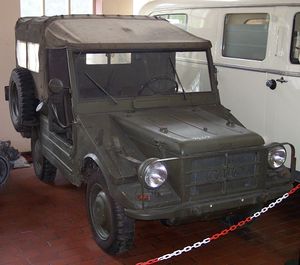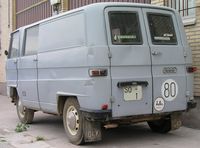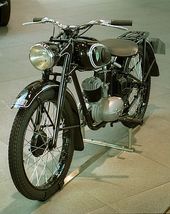.
DKW
Search By Model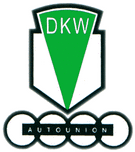
|
| Defunct |
Dampf-Kraft Wagen (German: steam-powered vehicle) or DKW is an historic car and motorcycle marque. In 1916, the Danish engineer Jørgen Skafte Rasmussen founded a factory in Saxony, Germany, to produce steam fittings. In the same year, he attempted to produce a steam-driven car, called the DKW. Although unsuccessful, he made a two-stroke toy engine in 1919, called Des Knaben Wunsch — "a boy's desire". He also put a slightly modified version of this engine into a motorcycle and called it Das Kleine Wunder — "a little marvel". This was the real beginning of the DKW brand: by the 1930s, DKW was the world's largest motorcycle manufacturer. In 1932, DKW merged with Audi, Horch and Wanderer to form the Auto Union, and all brands continued until World War II. After the war, Auto Union changed ownership a couple of times, first passed into the hands of Daimler-Benz in 1957, and was finally purchased by the Volkswagen Group in 1964.
Automobiles made before WWII
DKW cars were made from 1928 until 1966. They always used two-stroke engines and, from 1931, the company was a pioneer in front-wheel drive and transverse mounting. The most well-known cars made before World War II, bearing model names F1 through F8 (F for Front), had front-wheel drive and a transversely mounted two-cylinder engine. Displacement was 600 or 700 cc, power was 18 to 20 hp. These models also featured an innovation with a generator that doubled up as a self-starter, which was mounted directly on the crankshaft. This was known as a Dynastart.
They also produced a less well-known series of rear-wheel drive cars called Schwebeklasse and Sonderklasse with V4 two-stroke engines. Displacement of this engine was 1000 cc, later 1100 cc. These engines had two extra cylinders for forced induction, so they really appeared like V6es but without sparkplugs on the front cylinder pair.
In 1939, they made a prototype with the first three-cylinder engine. The engine had a displacement of 900 cc and produced 30 hp. With a streamlined body, the car could run at 115 Km/h (72 mph). This prototype was to be put into production only after the war, first as an IFA F9 (later to become Wartburg) in Zschopau, East Germany, and shortly afterwards in DKW-form from Düsseldorf as the 3=6 or F91.
DKW engines were used by Saab, as a model for their two-stroke engines in their new automobile manufacturing venture, in 1947.
Automobiles made after WWII
As the Auto Union company originally was situated in Saxony in what became the German Democratic Republic, it took some time before they gathered after the war was ended. The company was registered again in West Germany as Auto Union GMBH in 1949, first as a spare-part provider, but soon to take up production of the RT 125 motorcycle and a newly developed delivery van, called a Schnellaster F800. Their first line of production took place in Düsseldorf. This van used the same engine as the last F8 made before the war.
Their first passenger car was the F89 using the body from the prototype F9 made before the war and the 2 cylinder two-stroke engine from the last F8. Production went on until it was released by the successful 3 cylinder engine which came with the F91. The F91 was in production from 1953 to 1955, and was replaced by the somewhat larger F93 in 1956. The F91 and F93 models all had 900 cc 3-cylinder two-stroke engines, the first ones delivering 34 hp, and the last ones 38 hp. The ignition system of these engines comprised three independent sets of points and coils, one for each cylinder, with the points mounted in a cluster around a single lobed cam at the front end of the crank shaft. The cooling system was of the free convection type assisted by a fan driven from a pulley mounted at the front end of the crank shaft.
The F93 was produced until 1959, and was in turn replaced by the AU1000. These models where produced with a 1000 cc two-stroke engine, with a choice between 44 or 50 hp S versions until 1963. During this transition, production was also moved from Düsseldorf to Ingolstadt where Audi still have their production. From 1957, these cars could be fitted with an optional saxomat, an automatic clutch and, at the time it was the only small car offering this feature. The last versions of the AU1000S also had disk brakes as option, an early development for this technology. A sporting 2+2 seater version was also available as the AU1000 Sp from 1957 to 1964, the first years only as a coupé and from 1962 also as a convertible.
In 1956, the very rare DKW Monza was put into small scale production on a private initiative. This was a sporting, two-seater body made of glassfiber mounted on a standard F93 frame. The car was first called Solitude, but got its final name from the several long distance speed records it made on the Monza racing track in Italy in November 1956. Running in FIA class G, it set several new records, among them 48 hours with average speed 140.961 km/h, 10.000 km with average speed 139.453 km/h and 72 hours with average speed 139.459 km/h. The car was first produced by Dannenhauer & Stauss in Stuttgart, then by Massholder in Heidelberg and at last by Robert Schenk in Stuttgart. The total number of produced cars is said to be around 230 and production was rounded up by the end of 1958.
A more successful range of passenger cars was put out on the marked from 1959. This was the Junior/F12 series based on a modern concept from the late 50ies. This range consist of Junior (basic model) made from 1959 to 1961, Junior de Luxe (a little enhanced) from 1961 to 1963, F11 (a little larger) and F12 (larger and bigger engine) from 1963 to 1965 and F12 Roadster from 1964 to 1965. The Junior/F12 series became quite popular, and many cars were produced.
All the 3-cylinder two-stroke post-war cars had some sporting potential and formed the basis for many rally victories in the 1950s and beginning of 1960s. This made DKW the most winning car brand in the European rally league for several years during the fifties.
In 1960 DKW developed a V6 engine by combining two three cylinder two-stroke engines giving a single V6 engine with a capacity of 1000 cc. Over time the capacity was increased and the final V6 in 1966 had a capacity of 1300 cc. The 1300 cc version developed 83 HP at 5000 rpm using the standard configuation with two carburettors. A four carburettor version produced 100 HP and a six carburettor version produced 130 HP. The engine was very light and weighed only 84 kg. The V6 was planned to be used in the Munga and the F102. About 100 V6 engines was built for testing purposes and 13 DKW F102 as well as some Mungas was fitted with the V6 engine in the 1960s. [1]
The last DKW was the F102 coming into production in 1964 as a release for the somewhat old-looking AU1000. This model was the direct forerunner of the first post-war Audi 60, the main difference being that the Audi used a conventional four-stroke engine.
Vans and utility vehicles
The Munga
The word "MUNGA" comes from the German phrase "Mehrzweck UNiversal Geländewagen mit Allradantrieb", which translated means, " Multi purpose Universal Cross-country Car with All-wheel drive".
This car was built by Auto Union, Ingolstadt. The production began in October 1956 and ended in December 1968. During this time 46, 750 cars were built. The 38th International Motor Show at Frankfurt in the autumn 1957 was a great success for AUTO UNION GmbH. About this time the DKW cross-country car was launched. The vehicle, which has extraordinary stamina, was not only adopted by the West German „Bundeswehr“ as a vehicle unique in its class but was also bought in large numbers for the German Border Police and various foreign military formations within NATO.
The civilian version of the DKW cross-country car was widely adopted in Western Germany for agricultural and forestry work in particular, and also became popular abroad, especially in those countries where „go anywhere“ transport was needed because of poor roads, as, for example, in large parts of South America and South- Africa. Around 2000 cars were delivered to the Dutch army, many of which were shipped to the UK in the late 1970s. More information you will find by: www.munga-ig.de
The Van
From 1949 to 1962, DKW produced a van with a trailing-arm rear suspension system which incorporated springs in the cross bar assembly. It had a very modern layout with a front engine and front-wheel drive, but the engine was terribly weak. First the van used the prewar engine of the F8 with two cylinders, 700 cc and 20 hp (22 hp after 1952). This was definitely not enough when the van was fully charged. Things went (a little) better in 1955 when the van received the three cylinder unit with 900 cc, producing 32 hp.
Thanks to its layout the van had a low floor configuration, with the load areas about 40 cm from the ground. It was also fitted with a large single rear door fitted to hinges on the right-hand side. The van proved popular; one example being a company in Stellenbosch, South Africa, that sold musical instruments: their DKW van, used for the transport of pianos because of the low floor and large door, became iconic in the town.
The van was also produced in Vitoria, Spain. DKW (pronounced "de-ca-uve") become a common term for any van, and is still used today. The Spanish subsidiary also produced a modern successor, introduced in 1963 and called DKW F 1000 L. This van started with the three cylinder 1000 cc engine, but later received a Mercedes-Benz Diesel engine and finally was renamed a Mercedes-Benz.
Motorcycles
Before World War II, the company had some success with forced induction racing bikes, and during the 1920s and 1930s, DKW was the world largest motorcycle manufacturer. After the war, the company made the RT125, 175, 250 and 350 models.
The motorcycle branch of the company produced very famous models such as the RT125 pre- and post World War II. As reparations after the war, the design drawings of the RT125 were given to Harley-Davidson in the US and BSA in the UK. The HD version was known as the Hummer, while BSA used them for the Bantam. IFA and later MZ models continued in production until the 1990s, when economics finally brought production of the two stroke to an end. Other manufacturers also copied the DKW design, officially or otherwise. This can be seen in the similarity of many small two stroke motorcycles from the 1950s, including a product of Yamaha, Voskhod and Polish WSK.
External links
| Wikimedia Commons has media related to: |
- MUNGA Club
- DKW Munga picture
- DKW Club Nederland
- Site with many pictures and link list DKW Owners Club South Africa
- DKW Monza
- DKW Club of America
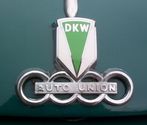
| ||
| DKW | ||
|
· · · · · · · · · · · · · Motor Racing: · · · · · · · · · · · · · Concept: · · · · · · · · · · · · ·
| ||
| Jørgen Skafte Rasmussen | DKW Club of America Fan website | A member of the Auto Union |










